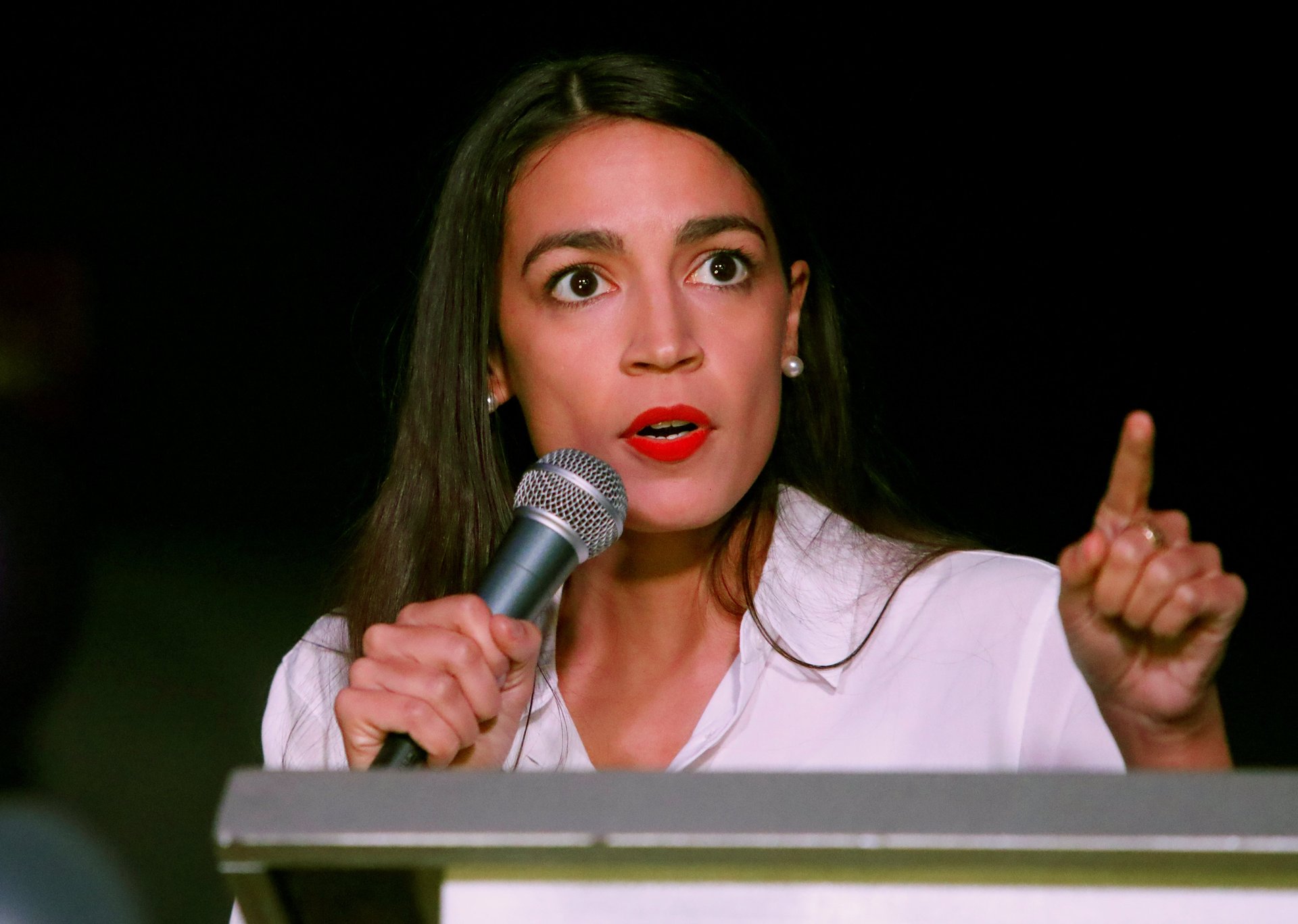These are the science concepts you need to know to understand political life in 2019
Issues anchored in science continued to play a growing role in politics and governance in 2018, and 2019 is shaping up to be much the same. It’s a truly global trend, as well: As we write, the “yellow-vest” protestors in France continue into their seventh week; though they have a wider economic ambit, the rallies were triggered by French president Emmanuel Macron’s fuel tax, a policy designed to help the country meet its climate change-mitigation targets.


Issues anchored in science continued to play a growing role in politics and governance in 2018, and 2019 is shaping up to be much the same. It’s a truly global trend, as well: As we write, the “yellow-vest” protestors in France continue into their seventh week; though they have a wider economic ambit, the rallies were triggered by French president Emmanuel Macron’s fuel tax, a policy designed to help the country meet its climate change-mitigation targets.
In the US, the Environmental Protection Agency under Trump has begun to more aggressively roll back protections put in place during the Obama era, and will likely push even harder next year. On the other hand, in the legislative branch, advocates for the environment in the House of Representatives have been reinvigorated by a wave of newly elected Democratic legislators who ran on platforms with various iterations of a “Green New Deal” that puts climate change front and center of policymaking.
In Beijing, party ministries are planning major policy initiatives designed to support developing lithium-ion battery capacity, electric car production, and possibly even setting renewable-power quotas. The Chinese government also will spend 2019 hashing out the details of a new plan to crack down on air pollution.
And that’s just energy-related policy. In the medical sciences, major questions will need to be addressed in the coming year on issues like gene-modified human cells, the aging of the global population, and how to deal with the acceleration of new drugs in the development pipeline.
Here are 15 terms or concepts (in alphabetical order) the Quartz science team believes are essential to understanding politics and public life in 2019.
ESG investing
Fighting climate change will require large changes in how the global economy works. That’s what ESG (environmental, social, and governance) investing hopes to achieve. It’s the term used by investors when they say the include environmental, social, and governance factors into their decision making. Ultimately, the goal is to align investments with what’s good for the world. ESG-managed assets rose from about $4 trillion in 2011 to $12 trillion in 2017.
But problems are starting to show. There is no global standard to determine how to measure each of these factors, and without standards, all investment could claim to be ESG investment—making the term meaningless. Fortunately, the industry has recognized this is an impending issue, and is now investigating ways to reform. Expect 2019 to bring more clarity. —Akshat Rathi
ETS
The European Union Emissions Trading Scheme (ETS) is the world’s largest carbon market. It places a cap on the total amount of carbon emissions that industries and electricity producers can put out, and then allows excess carbon credits to be traded on the market.
In the decade since the 2008 financial crisis, the price of a credit on the ETS was too low to have a measurable impact, because the EU assumed economic growth at pre-recession levels. That led to an oversupply of credits on the market. In 2018, however, the EU announced that it will be taking steps bring down supply to better align with demand. And in less than 12 months, the market price for each ton of carbon dioxide rose from €7 ($8) to €25 ($28.5). Expect the price to steadily climb up to as much as €30 or more (paywall) over the next few years. —Akshat Rathi
Expanded access
MDMA (better known as ecstasy) as a treatment for post-traumatic stress disorder has already been designated “breakthrough therapy” by the US Food and Drug Administration, meaning it will be fast-tracked through the regulatory process. Industry watchers expect the FDA to approve the treatment for “expanded access” in 2019, meaning that, even though trials are ongoing, patients who are expected to benefit from the treatment will have access to the MDMA therapy.
These patients must have PTSD and be recommended for the treatment by their physician, but do not have to be part of the clinical trials. Essentially, this means that Americans with PTSD will be able to benefit from MDMA treatment before it receives official FDA approval. In the coming year, expanded access could expand to other currently illegal drugs that are now under consideration for medicinal purposes, including psilocybin. —Olivia Goldhill
FFS healthcare
Since former pharmaceutical executive Alex Azar took over the role of US Secretary of Health, he’s pushed for an agenda based on the concept of “value-based” reforms to the country’s healthcare system. At its core, the idea is, essentially, about making the healthcare market more like any other, with a range of sellers offering a range of products at a range of prices, and where buyers are responsible for making their own purchasing decisions. In theory, this creates competition among providers, driving prices down and increasing quality.
The problem is that the US healthcare system currently looks nothing like that. Prices are hidden, and, thanks to years of industry obstinance, providers don’t typically publicize health outcomes of their practice. So there’s no way to assess their quality. This, in a phrase, is FFS healthcare. You’d be excused for thinking it actually stood for “for-fuck’s-sake healthcare,” given how the majority of Americans typically learn about the costs of their healthcare: either in a rejection letter from their insurance provider, or after the fact, in a shocking billing statement. But it actually means “fee-for-service healthcare,” which is what it sounds like: a system that pays based on quantity and not quality.
That said, there is little confidence among experts that a value-based system of the sort Azar is urging will actually work. Among many concerns raised is the fact that pilot efforts along these lines have, in the past, led to providers gaming the system, resulting in even poorer outcomes and even more wasted money. But Azar appears to be pushing ahead. On Jan. 1, one of the key provisions of Azar’s agenda will go into effect, forcing hospitals to publish the prices of standard services online. Expect more to come later in 2019. —Elijah Wolfson
The Green New Deal
In the US, Republicans usually have an answer to policies promoted by Democrats and vice versa. Curiously, that doesn’t seem to be the case when it comes to climate change. Even though the current US administration under Donald Trump is doing its utmost to roll back environmental regulations and promote the interests of carbon-heavy industries, the Democrats in power don’t yet have an answer. Now, a small faction within the Democratic party, mostly made up of the younger members, is pushing for a Green New Deal as a solution.

The origin of the idea goes back to a 2007 New York Times column by journalist Thomas Friedman. Though policy details of the GND have not yet been set out in detail, it broadly argues for large investments in clean energy and infrastructure with the simultaneous goals of lowering emissions and reducing inequality. As Democrats gain control of the House of Representatives in 2019, expect to hear “Green New Deal” often. With a Republican majority in the Senate, however, don’t expect more. —Akshat Rathi
LSEVs
With lavish government subsidies, China sold some 1 million electric cars in 2018 (membership). That’s more than the entire rest of the world sold the same year. On top of that, China sold nearly twice as many low-speed “micro-EVs” (about 1.75 million in 2017, paywall), and almost certainly just as much or more low-speed electric two-wheelers. Though precise numbers are hard to get, China currently has 99% of the world’s 250 million electric two-wheelers.
These low-speed electric vehicles (LSEVs) are perfect in small cities where daily commutes are under 30 km (18.5 miles) and where public transportation isn’t always available. Electricity as a fuel is cheaper than gasoline, which makes LSEVs overall more affordable to own than gasoline-powered cars. They come with a pretty significant bonus for the planet: about 80% of avoided carbon emissions (membership) from the use of electric vehicles can be attributed to China’s LSEVs. Even without direct subsidies, expect LSEV sales in China to continue to grow in 2019. —Akshat Rathi
Megadrought
A megadrought is a drought that lasts 20 years or longer. The Earth hasn’t seen one of these in modern history, but tree rings tell us they happened before human record keeping began, and in some cases were linked to the collapse of indigenous civilizations. And, we are probably overdue for the next one. In 2016, NASA scientists published a study suggesting our current trajectory of global warming has pushed the likelihood of megadrought in the North American Southwest before 2100 above 70%. If there’s also a decrease in precipitation over the North American Southwest in the coming years, the possibility of a “searing megadrought,” starting before 2100 and lasting more than 35 years goes up to 99%.
With arid regions growing more arid, it’s likely that the spire of megadrought will loom larger in 2019, and be a word more often on scientists’ lips going forward. The thing is, we can’t know if we’re in a megadrought until it’s over. For example, it might be the case that the Rio Grande region, on the US-Mexican border, is in a megadrought right now. “It’s possible that the next big megadrought is upon us, and we’re right in the middle of it,” David Gutzler, a University of New Mexico climate scientist said in March. “We’ll know it’s ended after it’s ended, but not before.” —Zoë Schlanger
Nuisance flooding
Most of the time, when we think of “flooding” we think of flash floods, that come fast and strong. Nuisance flooding, on the other hand, occurs regularly in certain parts of the coastal world, typically at high tide (you might also hear it called “high-tide flooding”). As sea levels rise, high tides are getting ever-higher. Miami Beach knows all about this; in recent years, the city has been flooding at high tide so regularly that when New Yorker reporter Elizabeth Kolbert visited in 2015, she was able to plan her visit to coincide with an inundation. This year, a Federal Emergency Management Agency official told an insurance conference audience to look at their driver’s licenses: “If it says Florida, you need flood insurance,” he said.

Thanks to the continuous march of sea-level rise, 2019 is sure to see even more nuisance floods. And as time goes on, the term will be impossible to miss: High-tide flooding is set to be a weekly reality for parts of the coastal US like New York and San Francisco by 2050, and a daily occurrence for major coastline cities by 2100. —Zoë Schlanger
Kosher pork
With governments around the globe now working on how to best regulate cell-cultured meats, Jewish and Muslim religious scholars are beginning to mull how these new, high-tech meats will fit within the context of their own established dietary rules. The conversation began to percolate in 2018 within the rabbinical community, and now authorities at the powerful Orthodox Union are openly questioning whether cell-cultured pork—having never involved the slaughtering of an actual pig at all—would be kosher. The short answer: maybe.
The latest thinking, according to Orthodox Union rabbi Menachem Genack, is that cell-cultured pork may very well considered a “neutral” food under the laws of kosher eating. Genack suggests that the cells collected from a pig to grow cell-cultured pork would lose their original identity and therefore would no longer be defined as forbidden for consumption. If that winds up being the case—and that conversation will be further fleshed out in 2019—cell-cultured meat stands to change religious dietary laws that have been in place for thousands of years. —Chase Purdy
PFOA/PFOS/PFAS
After years of debate and a major scientific report connecting PFOA to two cancers and several other serious diseases, the US Environmental Protection Agency appeared set to start regulating the contaminant in 2017. But two years into the Trump administration, that still hasn’t happened. Yet PFAS—the larger class of chemicals to which PFOA and PFOS belong—are bigger news now than they ever have been, sparking one of the most widespread drinking-water contamination revelations in recent decades and securing their place as the DDT of this generation.
PFOA is a chemical used in the nonstick coating Teflon, waterproof coating for clothing, and stain-resistors like Scotchgard. PFOS is used in a firefighting foam common on military bases and at airports. Both have been leaching into water supplies for decades, along with numerous other PFAS chemicals still being discovered. Companies that manufactured them obscured and downplayed evidence of the compounds’ harm and ubiquity in the environment for years. Once they get into the environment, they don’t break down, are now they turn up in the blood of most Americans. A growing body of research links PFAS to heightened cancer risks, infertility, developmental delays, and other health problems.
Communities in states as far-flung as West Virginia, New York, Michigan, Illinois, Pennsylvania, and Wisconsin have already dealt with water-contamination emergencies from the chemicals. The crisis isn’t contained to the US; at least 90 sites across Australia are contaminated with PFAS. We’ll almost certainly hear a lot more about this class of chemicals in 2019. —Zoë Schlanger
Sage grouse
It looks like a Thanksgiving-themed pin cushion. It’s a spectacle of the American West and a perpetual headache for oil companies seeking permission to bore into the grounds of more than 9 million acres of grassy plains across states including Nebraska, Montana, and the Dakotas. It is the sage grouse, a funky-looking bird that has been a candidate for endangered-species protection in the past, and whose current government protections have been one of the key obstacles keeping fossil-fuel interests from drilling into vast habitat.

During the administration of former US president Barack Obama, the federal government in 2015 banned or limited drilling on nearly 11 million acres. But Obama’s White House successor, Donald Trump, is less keen to keep protections for the bird, which means it’ll be one of the faces of resistance as environmental advocacy groups protest the continued weakening of environmental protection rules by the Trump administration. In December, Trump moved to remove protections from sage grouse habitats, according to The New York Times. —Chase Purdy
The sandwich generation
About five years ago, Generation X entered the “sandwich generation”—a term coined by a social worker named Dorothy Miller back in the 1980s—as they now care for both their own children and their Baby Boomer parents.
Across the globe—particularly in East Asia—life expectancies are increasing, which means that more adults are being pulled into the sandwich generation. One estimate from the Economist Intelligence Unit from 2010 suggests (pdf, p. 8) as many as 370 million adults in China were already sandwiched then, and that number has surely grown in the last eight years. The same report showed Hong Kong had 1.5 million sandwich adults, Japan had 5.4 million, South Korea had 6.9 million, and Taiwan had 3.5 million. In 2006 in the US, there were around 44 million people caring for both elderly relatives and children. In the UK, there were roughly 2.4 million sandwich caregivers in 2014 and in Australia, there were an estimated 1.5 million in 2013. In 2011, the World Bank estimated that the average Latin American should expect to spend about half their lives sandwiched.
Typically, the caregiving burdens fall on women, who are more likely than men to take off time from work to provide care for their families. As more adults enter the sandwich generation, it will be crucial for companies to provide resources like flexible hours, teleworking options, and resources for adult-care facilities so that all employees can contribute to care for their families while remaining in the workforce. —Katherine Ellen Foley
Solastalgia
As the psychological toll of climate change mounts, professionals are taking note: Last year, the American Psychological Association validated “ecoanxiety” as a clinically legitimate diagnosis. But few words exist to more specifically describe the grief many feel watching their home environments change as accelerating climate change removes the predictability of seasons—or, in the case of intensifying wildfires, storms, and floods, removes entire towns and landscapes. That’s where solastalgia comes in.
The word was coined by Australian philosopher Glenn Albrecht to describe homesickness for an environment that’s leaving without you. Solastalgia is a combination of three elements: “Solas” references the English word “solace,” which comes from the Latin root solarimeaning comfort in the face of distressing forces. But it is also a reference to “desolation,” which has its origins in the Latin solus and desolare, which both connote ideas of abandonment and loneliness. “Algia” comes from the Greek root -algia, which means pain, suffering, or sickness. —Zoë Schlanger
Tissue-agnostic
The vast majority of cancer treatments target specific parts of the body. However, in 2017, that started to change. That year, the US Food and Drug Administration approved the first “tissue-agnostic” cancer treatment, designed to work based on the genetic makeup of the tumor—regardless of where it appears in the body. Late in 2018, the FDA approved a second tissue-agnostic cancer treatment, and there are some 34 other compounds in this class of drug in early stages of development.
Targeting tumors based on their genetic mutations instead of their locations opens the door to new treatments for previously incurable types of cancer. However, the high costs of developing these drugs makes them extremely expensive, and at the moment it’s unclear if insurance providers will be willing to cover them, leaving patients to face out-of-pocket costs in the hundreds of thousands of dollars. —Katherine Ellen Foley
Trump anxiety disorder
In 2018, therapists began using the term “Trump anxiety disorder” to describe the insomnia, stress, and excessive time spent scanning for news on social media that many Americans have suffered from since Trump was elected US president. This condition isn’t a formal diagnosis, but an official description of a collection of symptoms, which therapists are using to describe politics-related stress.
Indeed, data show Americans have gotten more anxious under Trump. In May 2018, some 39% of people said their anxiety had risen compared to the previous year, according to a survey by the American Psychiatric Association. The majority of people (56%) said they were either extremely or somewhat anxious about the impact of politics on their daily life. With the threat of a government shutdown on the horizon and tense political relations, both domestically and internationally, this condition is unlikely to fade away any time soon. —Olivia Goldhill